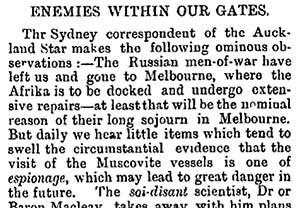Before 1885 there possibly would have been only a few people in New Zealand who had ever heard of the Panjdeh region in what is now Turkmenistan. To the British, it was considered a region of Afghanistan. The Russians, however, believed that the region was a tributary of Merv, a city that was part of the Khanate of Khiva, which had been a protectorate of the Russian Empire since 1873. For the British in India, the steady creep of the Russian Empire towards the north western borders of the Raj was a constant concern. Therefore, when Russian forces under General Alexander Komarov captured the Panjdeh region on 30 March 1885, it was expected that war between the two empires would immediately follow. Across the British Empire, all naval vessels were ordered to standby ready for deployment and the movement of all Russian military ships was closely monitored.
Lyttelton was ready to play its part in the defence of the empire with Torpedo Boat No. 168, Defender.
Torpedo Boat No. 168 Defender
The fear that New Zealand lay within the reach of Russian warships was made all too visible when, in 1881, the Russian war ship, Afrika visited Auckland. To defend its ports, New Zealand began to construct a series of costal fortifications. To accompany these fortifications, four torpedo boats were ordered.
Defender was one of four 2nd class Thornycroft Spar Torpedo Boats that were built in 1883 in Chiswick, London, by shipbuilding firm, John I. Thornycroft & Co. Powered by steam, and reaching 63 feet in length, each boat was armed with a McEvoy spar torpedo. Unlike the use of propelled torpedoes, which could be launched from a distance, spar torpedoes had to be driven into the side of the target. To provide cover as the boat moved to attack, a Nordenfeldt machine gun was situated on top of the conning tower.
After being tested, the boats were shipped to New Zealand, with the first two arriving aboard the Lyttelton in Port Chalmers on 9 May 1884. Assigned to Lyttelton, Defender arrived at the port in December 1884. The remaining boats were deployed to their new destinations. Taiaroa went to Port Chalmers, Waitemata to Devonport, and Poneke to Wellington. Following its arrival in Lyttelton, Defender was moored off Gladstone Pier where it remained under the authority of Captain Hugh McLellan, Harbour Master and Captain of the Naval Brigade. Ten men were chosen by McLellan to serve on the torpedo boat, assisted by five members of the Armed Constabulary. However, only five at a time would be on permanent duty.
The Defender of Baker's Bay
In 1885 it was decided to house Defender at Baker’s Bay (now called Magazine Bay) where a magazine building had previously been constructed in 1874 by the then Provincial Government to house black powder and explosives. A torpedo boat shed, large enough to house three boats, and a slip, was constructed. However, the location and design of the slip were criticised, as the boat could not be launched during a high tide or during swells. This was lampooned in an article in the Lyttelton Times with the suggestion that a placard be painted on Godley Head with the following: "To Russians and all others whom it may concern. Hostile parties wishing to shell the Port of Lyttelton are requested to time their visit for fine weather, otherwise they cannot be fittingly received by the local authorities."
Because Defender was only tested once every three months, and without a full time engineer to oversee its maintenance, its engines soon rusted. In March 1886 Rear-Admiral Robert A.E. Scott visited Lyttelton to observe a display of the boat’s performance. Unfortunately, due to the condition of its engines, the boat was only able to reach a speed of 12 knots. Later that year the boat was equipped with Whitehead mobile torpedoes.

Decommission, ruin and restoration
The predicted war with the Russian Empire never came. Since the ruler of Afghanistan, Emir Abdur Rahman Khan, remained unconcerned by the Russian occupation of Panjdeh, the British in India had no excuse to send military forces to the Russian-Afghan border on his behalf. When the threat of a Russian invasion passed, Defender remained idle. Although in 1888 it was suggested, in a report to the Government by General Shaw, that the boat be transferred to Wellington, she remained on inactive duty in Lyttelton.
In 1899 Defender was decommissioned and sold to Mark Thomas, a steam launch operator. He salvaged the boat’s vital parts before disposing of the hull on Purau Beach. It is believed that the conning tower eventually ended up in a paddock where it was used as trough. In 1909 the Mount Herbert County Council hired Alex Rhind and Co. to haul the remains of the boat further up the beach, a process which resulted in the hull breaking in half. The remains were still visible when artist Jess Hollobon painted a scene of Purau Beach in 1930. They were finally covered over in 1958.
In 1998 David Bundy was tasked by Project Port Lyttelton to locate and excavate the remains of Defender. Referring to an aerial photograph taken in 1958 of Purau beach, he was assisted by a team of soldiers using metal detectors. Eventually the remains were found, with some sections buried at a depth of 30 metres. After being excavated, the remains were taken to Lyttelton where they were restored. In 2003 the Lyttelton Torpedo Boat Museum Charitable Trust opened the Thornycroft Torpedo Boat Museum in the former magazine house and placed the restored remains, complete with a spar torpedo, on display. Today, the remains of Torpedo Boat No. 168, Defender are a reminder that colonial New Zealand, although located in the lower Pacific, was not immune from the effects of Russian and British expansion into the khanates of Central Asia.
Find out more
- Visit the Thornycroft Torpedo Boat Museum. (opening hours 1-3pm Sundays or by special arrangement)
- Learn about the Panjdeh incident in an article from the Lyttelton Times.
- Read about Admiral Scott's inspection of the torpedo boat in March 1886.
- Titles on the history of Lyttelton
- Lost Kingdom: The Quest for Empire and the Making of the Russian Nation, From 1470 to the Present






Add a comment to: Defending Lyttelton: Torpedo Boat No. 168 Defender